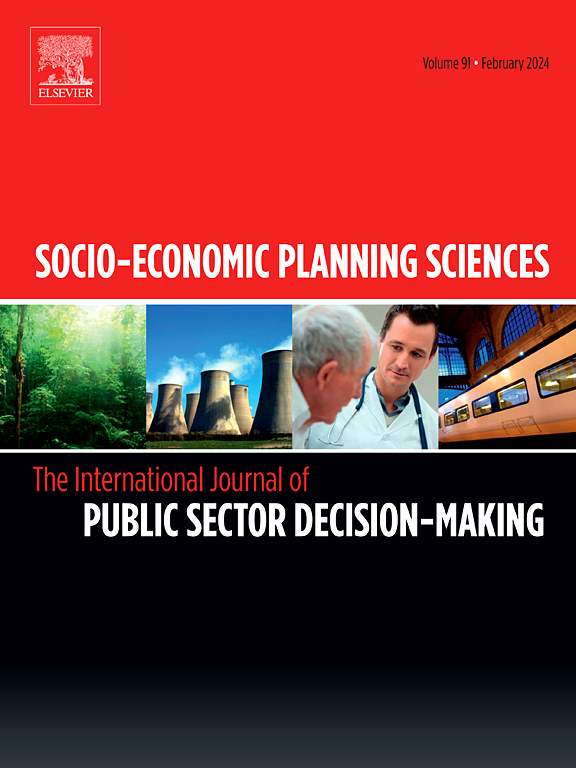Financing road projects and its impact on off-farm work in rural China
IF 5.4
2区 经济学
Q1 ECONOMICS
引用次数: 0
Abstract
Effective public sector decision-making in infrastructure financing is crucial for socio-economic development, especially in emerging economies. Since 2003, China has revamped its rural road construction policy, transitioning from “workers self-organised construction (Min Gong Jian Qin)" to a “one project, one discussion (Yi Shi Yi Yi)" approach and significantly increasing government investment. This study evaluates the impact of various financing sources—externally funded, self-financed, and mix financed—on rural off-farm income and migration intentions using the Chinese Household Income Project survey data, employing difference-in-differences and propensity score matching methodologies to analyze the socio-economic impacts of rural road projects financed through different sources on off-farm work income and migration intentions of the rural Chinese population. Findings reveal that externally funded road projects significantly enhance off-farm income and encourage migration intentions for work. Conversely, self-financed projects that rely on local villagers' contributions and voluntary labor, show no positive impact on off-farm income and unexpectedly reduce migration intentions. Importantly, projects with mixed financing models were found to have no significant impact on either off-farm income or migration patterns, highlighting challenges in the coordination and efficacy of these hybrid financing strategies. These results contribute to the discourse on public sector decision-making by demonstrating the critical role of government-funded infrastructure in facilitating socio-economic development in rural areas. The study underscores the importance of strategic resource allocation and effective financing models in enhancing rural infrastructure, increasing income, and enabling rural out-migration for improved livelihoods.
公路项目融资及其对中国农村非农就业的影响
公共部门在基础设施融资方面的有效决策对社会经济发展至关重要,尤其是在新兴经济体。自2003年以来,中国对农村公路建设政策进行了调整,从“工人自组织建设(民工建勤)”转变为“一工程一议”,并大幅增加了政府投资。本研究利用中国家庭收入项目调查数据,评估了各种融资来源(外部融资、自筹资金和混合融资)对农村非农收入和迁移意愿的影响,采用差异中差和倾向得分匹配方法,分析了不同来源的农村公路项目对中国农村人口非农工作收入和迁移意愿的社会经济影响。研究结果表明,外部资助的道路项目显著提高了非农收入,并鼓励了移民的工作意愿。相反,依靠当地村民捐款和自愿劳动的自筹项目对非农收入没有积极影响,出乎意料地降低了移民意愿。重要的是,采用混合融资模式的项目对非农收入或移民模式都没有显著影响,这凸显了这些混合融资策略在协调和有效性方面的挑战。这些结果通过展示政府资助的基础设施在促进农村地区社会经济发展方面的关键作用,有助于对公共部门决策的讨论。该研究强调了战略性资源配置和有效融资模式在加强农村基础设施、增加收入和促进农村人口向外迁移以改善生计方面的重要性。
本文章由计算机程序翻译,如有差异,请以英文原文为准。
求助全文
约1分钟内获得全文
求助全文
来源期刊

Socio-economic Planning Sciences
OPERATIONS RESEARCH & MANAGEMENT SCIENCE-
CiteScore
9.40
自引率
13.10%
发文量
294
审稿时长
58 days
期刊介绍:
Studies directed toward the more effective utilization of existing resources, e.g. mathematical programming models of health care delivery systems with relevance to more effective program design; systems analysis of fire outbreaks and its relevance to the location of fire stations; statistical analysis of the efficiency of a developing country economy or industry.
Studies relating to the interaction of various segments of society and technology, e.g. the effects of government health policies on the utilization and design of hospital facilities; the relationship between housing density and the demands on public transportation or other service facilities: patterns and implications of urban development and air or water pollution.
Studies devoted to the anticipations of and response to future needs for social, health and other human services, e.g. the relationship between industrial growth and the development of educational resources in affected areas; investigation of future demands for material and child health resources in a developing country; design of effective recycling in an urban setting.
 求助内容:
求助内容: 应助结果提醒方式:
应助结果提醒方式:


